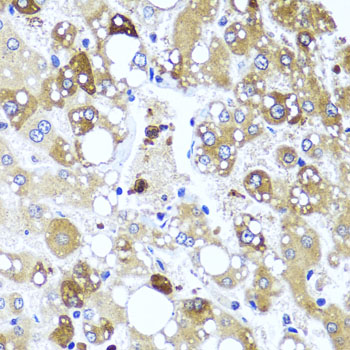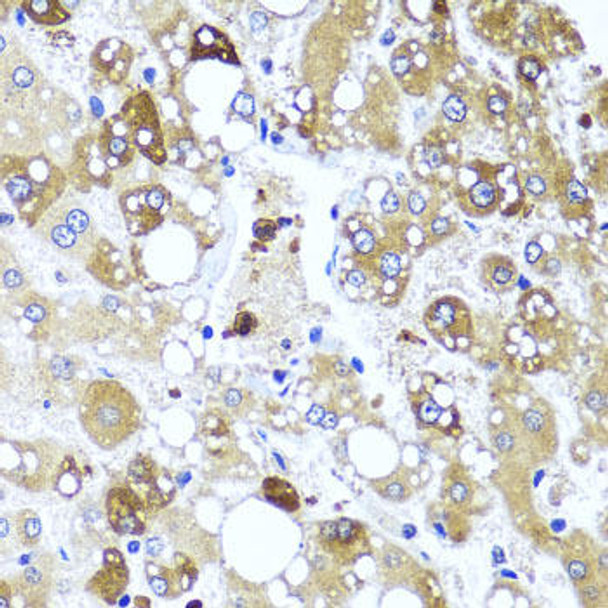Anti-IL-4 Antibody (CAB5649)
- SKU:
- CAB5649
- Product type:
- Antibody
- Reactivity:
- Human
- Host Species:
- Rabbit
- Isotype:
- IgG
- Antibody Type:
- Polyclonal Antibody
- Research Area:
- Immunology
Description
| 抗体名: | IL4 Rabbit Polyclonal Antibody |
| 抗体コード: | CAB5649 |
| 抗体サイズ: | 20uL, 50uL, 100uL |
| 申し込み: | WB IHC |
| 反応性: | Human |
| 宿主種: | Rabbit |
| 免疫原: | Recombinant fusion protein containing a sequence corresponding to amino acids 25-153 of human IL4 (NP_000580.1). |
| 申し込み: | WB IHC |
| 推奨希釈: | WB 1:500 - 1:2000 IHC 1:50 - 1:100 |
| 反応性: | Human |
| ポジティブサンプル: |
| 免疫原: | Recombinant fusion protein containing a sequence corresponding to amino acids 25-153 of human IL4 (NP_000580.1). |
| 精製方法: | Affinity purification |
| ストレージバッファ: | Store at -20'C. Avoid freeze / thaw cycles. Buffer: PBS with 0.02% sodium azide, 50% glycerol, pH7.3. |
| アイソタイプ: | IgG |
| 順序: | HKCD ITLQ EIIK TLNS LTEQ KTLC TELT VTDI FAAS KNTT EKET FCRA ATVL RQFY SHHE KDTR CLGA TAQQ FHRH KQLI RFLK RLDR NLWG LAGL NSCP VKEA NQST LENF LERL KTIM REKY SKCS S |
| 遺伝子ID: | 3565 |
| Uniprot: | P05112 |
| セルラーロケーション: | Secreted |
| 計算された分子量: | 15kDa/17kDa |
| 観察された分子量: | Refer to figures |
| 同義語: | IL4, BCGF-1, BCGF1, BSF-1, BSF1, IL-4 |
| バックグラウンド: | The protein encoded by this gene is a pleiotropic cytokine produced by activated T cells. This cytokine is a ligand for interleukin 4 receptor. The interleukin 4 receptor also binds to IL13, which may contribute to many overlapping functions of this cytokine and IL13. STAT6, a signal transducer and activator of transcription, has been shown to play a central role in mediating the immune regulatory signal of this cytokine. This gene, IL3, IL5, IL13, and CSF2 form a cytokine gene cluster on chromosome 5q, with this gene particularly close to IL13. This gene, IL13 and IL5 are found to be regulated coordinately by several long-range regulatory elements in an over 120 kilobase range on the chromosome. Two alternatively spliced transcript variants of this gene encoding distinct isoforms have been reported. |
| UniProt Protein Function: | IL4: Participates in at least several B-cell activation processes as well as of other cell types. It is a costimulator of DNA-synthesis. It induces the expression of class II MHC molecules on resting B-cells. It enhances both secretion and cell surface expression of IgE and IgG1. It also regulates the expression of the low affinity Fc receptor for IgE (CD23) on both lymphocytes and monocytes. Genetic variations in IL4 may be a cause of susceptibility to ischemic stroke (ISCHSTR); also known as cerebrovascular accident or cerebral infarction. A stroke is an acute neurologic event leading to death of neural tissue of the brain and resulting in loss of motor, sensory and/or cognitive function. Ischemic strokes, resulting from vascular occlusion, is considered to be a highly complex disease consisting of a group of heterogeneous disorders with multiple genetic and environmental risk factors. Belongs to the IL-4/IL-13 family. 2 isoforms of the human protein are produced by alternative splicing. |
| UniProt Protein Details: | Protein type:Cell cycle regulation; Cytokine; Motility/polarity/chemotaxis; Secreted; Secreted, signal peptide Chromosomal Location of Human Ortholog: 5q31.1 Cellular Component: extracellular space; external side of plasma membrane Molecular Function:protein binding; growth factor activity; cytokine activity; interleukin-4 receptor binding Biological Process: regulation of isotype switching; positive regulation of isotype switching to IgG isotypes; negative regulation of osteoclast differentiation; positive regulation of transcription, DNA-dependent; microglial cell activation; regulation of proton transport; female pregnancy; positive regulation of activated T cell proliferation; chemotaxis; response to organic cyclic substance; positive regulation of isotype switching to IgE isotypes; positive regulation of interleukin-10 production; B cell costimulation; connective tissue growth factor biosynthetic process; positive regulation of MHC class II biosynthetic process; positive regulation of B cell proliferation; positive regulation of T cell proliferation; positive regulation of interleukin-13 production; negative regulation of macrophage activation; response to nutrient; response to drug; cholesterol metabolic process; regulation of immune response; negative regulation of chronic inflammatory response; T-helper 2 type immune response; regulation of phosphorylation; B cell activation; negative regulation of nitric oxide biosynthetic process; negative regulation of acute inflammatory response; defense response to protozoan; T-helper 1 cell lineage commitment; response to ethanol; positive regulation of chemokine biosynthetic process; positive regulation of tyrosine phosphorylation of Stat5 protein; positive regulation of T cell differentiation; innate immune response in mucosa; retina development in camera-type eye; B cell differentiation; response to cytokine stimulus; cellular defense response; immune response; positive regulation of transcription from RNA polymerase II promoter; positive regulation of transcription factor activity; T-helper 2 cell differentiation; negative regulation of transcription, DNA-dependent; positive regulation of defense response to virus by host; negative regulation of apoptosis Disease: Stroke, Ischemic |
| NCBI Summary: | The protein encoded by this gene is a pleiotropic cytokine produced by activated T cells. This cytokine is a ligand for interleukin 4 receptor. The interleukin 4 receptor also binds to IL13, which may contribute to many overlapping functions of this cytokine and IL13. STAT6, a signal transducer and activator of transcription, has been shown to play a central role in mediating the immune regulatory signal of this cytokine. This gene, IL3, IL5, IL13, and CSF2 form a cytokine gene cluster on chromosome 5q, with this gene particularly close to IL13. This gene, IL13 and IL5 are found to be regulated coordinately by several long-range regulatory elements in an over 120 kilobase range on the chromosome. Two alternatively spliced transcript variants of this gene encoding distinct isoforms have been reported. [provided by RefSeq, Jul 2008] |
| UniProt Code: | P05112 |
| NCBI GenInfo Identifier: | 124337 |
| NCBI Gene ID: | 3565 |
| NCBI Accession: | P05112.1 |
| UniProt Secondary Accession: | P05112,Q14630, Q6NZ77, |
| UniProt Related Accession: | P05112 |
| Molecular Weight: | 15,797 Da |
| NCBI Full Name: | Interleukin-4 |
| NCBI Synonym Full Names: | interleukin 4 |
| NCBI Official Symbol: | IL4 |
| NCBI Official Synonym Symbols: | BSF1; IL-4; BCGF1; BSF-1; BCGF-1 |
| NCBI Protein Information: | interleukin-4; binetrakin; pitrakinra; B cell growth factor 1; interleukin 4 variant 2; B_cell stimulatory factor 1; lymphocyte stimulatory factor 1 |
| UniProt Protein Name: | Interleukin-4 |
| UniProt Synonym Protein Names: | B-cell stimulatory factor 1; BSF-1; Binetrakin; Lymphocyte stimulatory factor 1; Pitrakinra |
| Protein Family: | Interleukin |
| UniProt Gene Name: | IL4 |
| UniProt Entry Name: | IL4_HUMAN |
 | Immunohistochemistry of paraffin-embedded human liver damage using IL4 antibody (CAB5649) at dilution of 1:100 (40x lens). |

